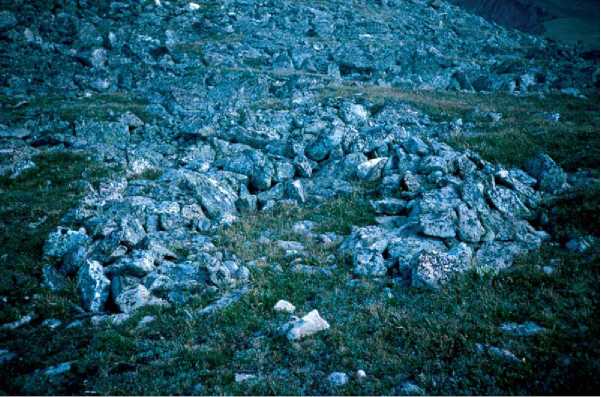This chapter has provided a flavor for the prehistory of the Rocky Mountains, both in terms of the archaeological record that prehistoric people left behind and the lifestyles they led. A key theme of the chapter has

Figure 7 A game blind associated with an alpine game drive system in the Devil’s Thumb Pass area of the Indian Peaks Wilderness, west of Boulder, Colorado. This blind, like the many others associated with game drives in the vicinity, providedcoverfor hunters waiting to ambush elk and bighorn sheep. Sites associated with Devil’s Thumb game drives have been dated to older than 9000 radiocarbon years before present through the recent past.
Been flexibility. From the time people first occupied the Rocky Mountains over 10 000 years ago, they have taken full advantage of the suite of subsistence resources available on a vertically oriented landscape and of the many potentially successful land-use options available for exploiting those resources at any given moment.
Archaeological evidence suggests that from the dawn of human use of the Rockies, some groups chose to live there full-time, occupying all environmental zones (though not always in the same way from culture to culture, or even from year to year). Evidence also suggests that again, even during the earliest period of use, other groups viewed the Rockies as a seasonal retreat from the grasslands to the east or arid lands to the west. This pattern of multiple-use continued throughout the Archaic, For-mative/Late Prehistoric, and Protohistoric periods, culminating in historic and ethnographic accounts of Shoshone, Ute, and other indigenous mountain groups that mesh neatly with reconstructions of prehistoric land use.
Reasons why prehistoric people used the Rockies were as varied as the environmental zones that morph so dramatically with elevation and latitude. For some, the Rocky Mountains were home-sweet-home, meeting every conceivable human need during every season of the year. For others, the Rockies were a place to temporarily rendezvous with friends and family, escape the heat of a Plains or Great Basin summer, hunt bighorn or elk via communal game drives or bison in mountain parks, procure raw materials for making chipped stone and groundstone tools, harvest pifion or other pine nuts to store for winter consumption back at a Far Western residential base, or pay homage to the spirits who dwell there. In fact, as any resident of Jackson, Wyoming or any Plains, or Far Western travel agent will attest, although the details may have changed a bit, the mountains continue to play a vital and dynamic role in the lives of contemporary westerners who rely on them for economic, social, and spiritual fulfillment.
See also: Americas, North: American Southwest, Four Corners Region; Eastern Woodlands; Plains; Sub-arctic.




 World History
World History









